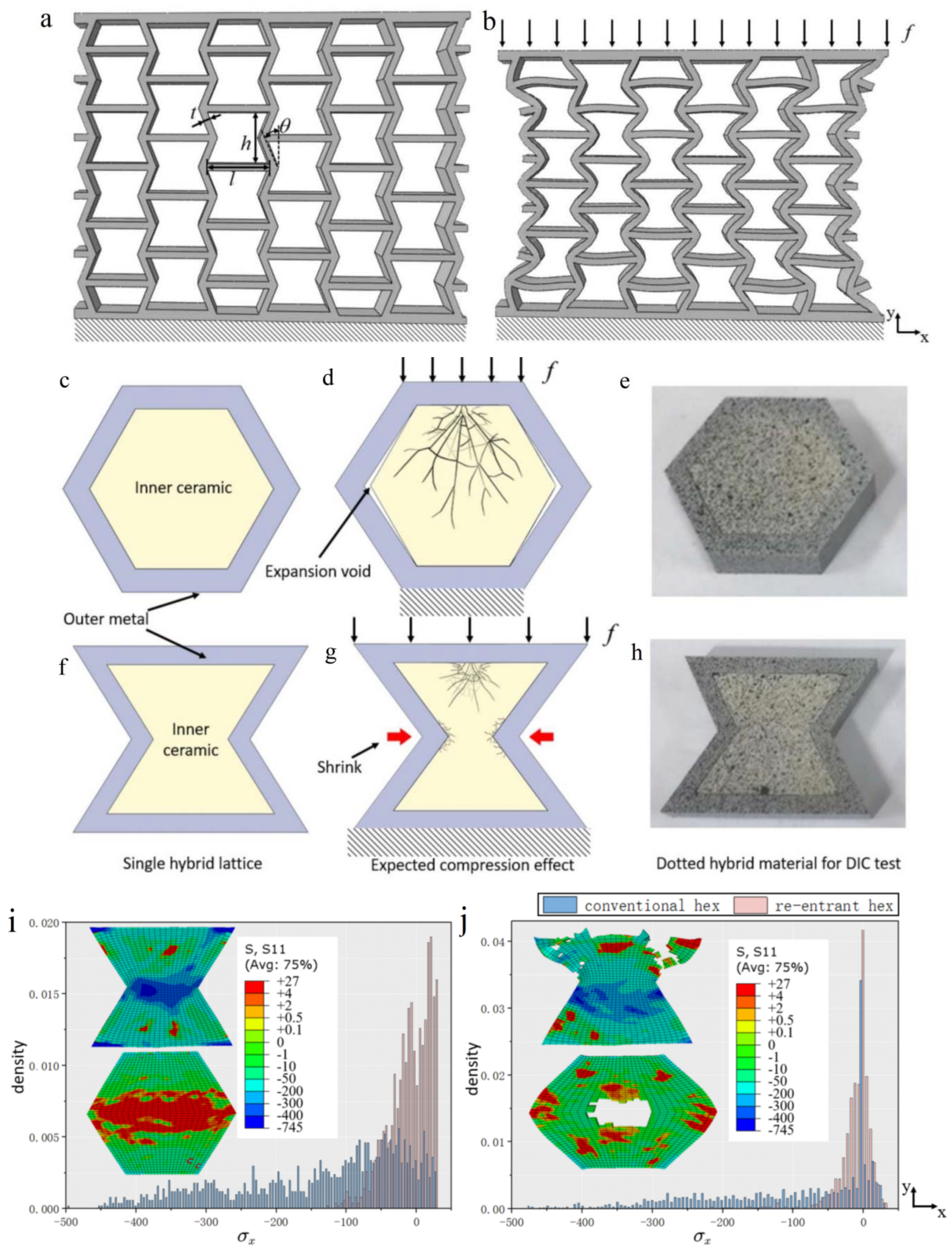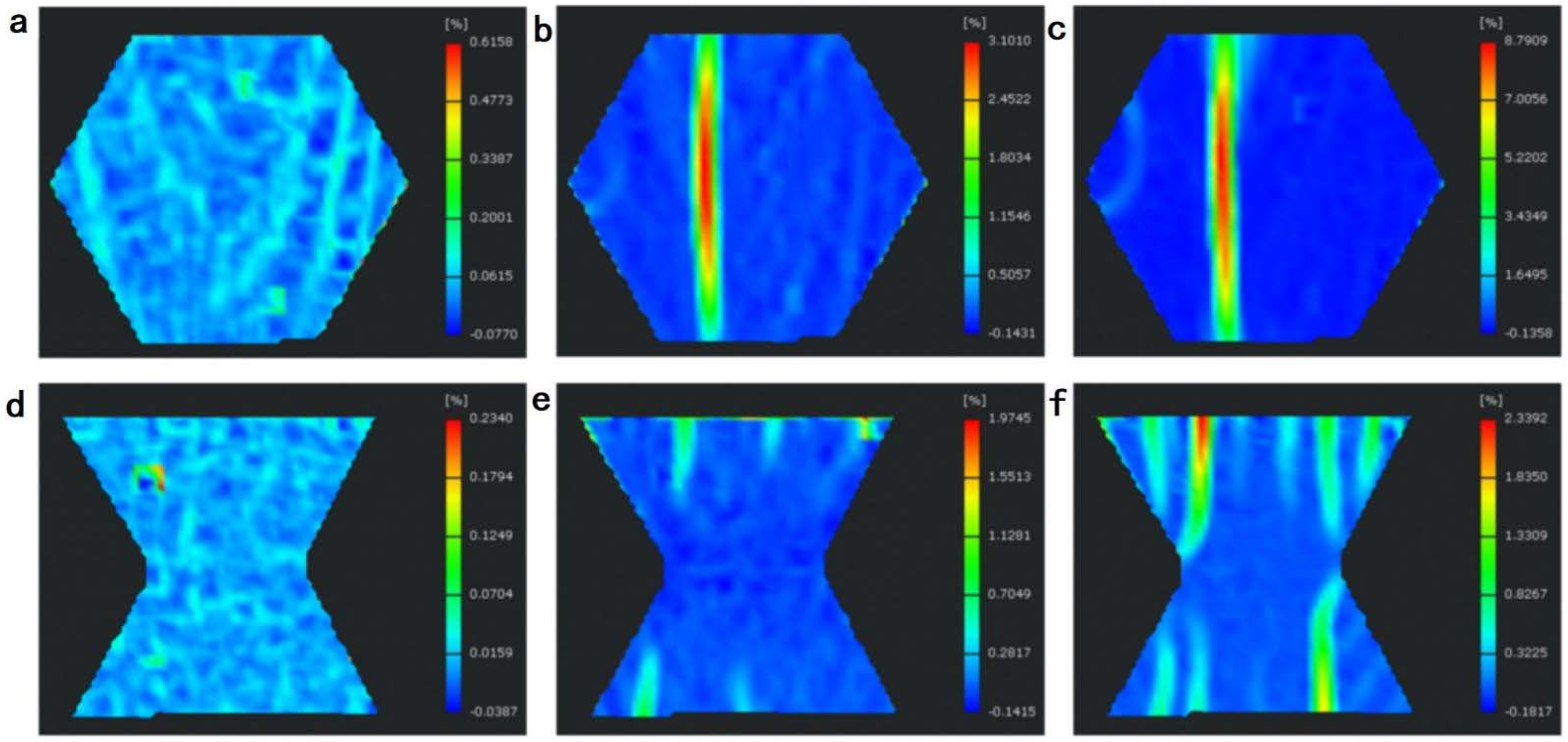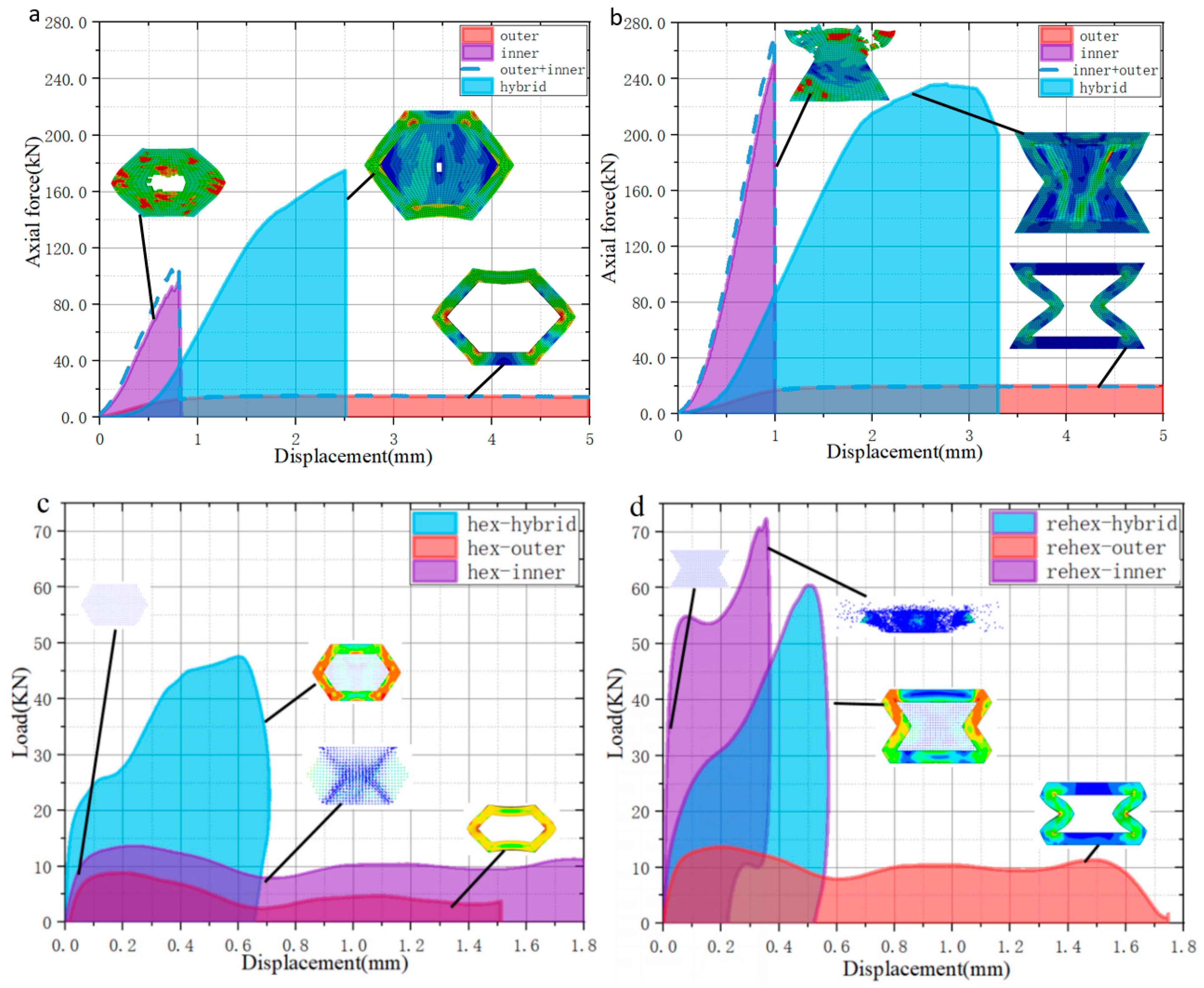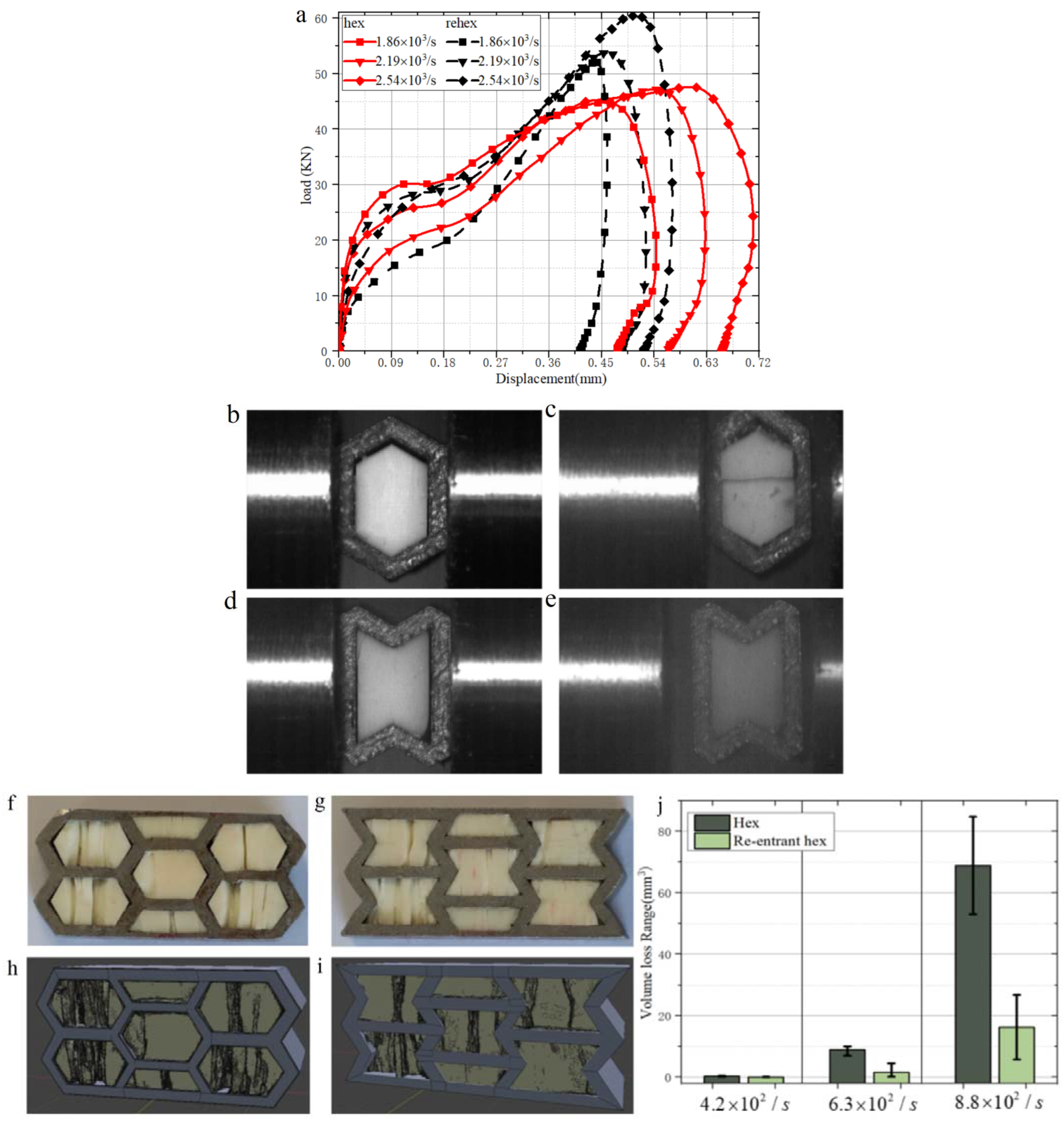Experimental Investigations on the Mechanical Performances of Auxetic Metal-Ceramic Hybrid Lattice under Quasi-Static Compression and Dynamic Ballistic Loading
Abstract
:1. Introduction
2. Synergistic Mechanical Design of Strength and Toughness with Ceramic-Infilled Re-Entrant Lattice
3. Fabrication and Experiment Schedule
4. Results and Discussion
4.1. Mechanical Tests
4.2. Dynamic Mechanical Tests
5. Conclusions and Discussions
Author Contributions
Funding
Institutional Review Board Statement
Informed Consent Statement
Data Availability Statement
Acknowledgments
Conflicts of Interest
References
- Wilkins, M.L. Mechanics of penetration and perforation. Int. J. Eng. Sci. 1978, 16, 793–807. [Google Scholar] [CrossRef]
- Han, C.; Sun, C. A study of pre-stress effect on static and dynamic contact failure of brittle materials. Int. J. Impact Eng. 2000, 24, 597–611. [Google Scholar] [CrossRef]
- Hu, P.; Cheng, Y.; Zhang, P.; Liu, J.; Yang, H.; Chen, J. A metal/UHMWPE/SiC multi-layered composite armor against ballistic impact of flat-nosed projectile. Ceram. Int. 2021, 47, 22497–22513. [Google Scholar] [CrossRef]
- Rodríguez-Castro, R.; Wetherhold, R.; Kelestemur, M. Microstructure and mechanical behavior of functionally graded Al A359/SiCp composite. Mater. Sci. Eng. A 2002, 323, 445–456. [Google Scholar] [CrossRef]
- Guoxi, L. Design and Optimization for Structure of TiB2/Ti FGM Armor. Ph.D. Thesis, Northwestern Polytechnical University, Xi’an, China, 2016. [Google Scholar]
- Anderson, C.E.; Royal-Timmons, S.A. Ballistic performance of confined 99.5%-Al203 ceramic tiles. Int. J. Impact Eng. 1997, 19, 703–713. [Google Scholar] [CrossRef]
- Traxel, K.D.; Bandyopadhyay, A. Naturally architected microstructures in structural materials via additive manufacturing. Addit. Manuf. 2020, 34, 101243. [Google Scholar] [CrossRef]
- Han, B.; Zhang, Z.-J.; Zhang, Q.-C.; Zhang, Q.; Lu, T.J.; Lu, B.-H. Recent advances in hybrid lattice-cored sandwiches for enhanced multifunctional performance. Extreme Mech. Lett. 2017, 10, 58–69. [Google Scholar] [CrossRef]
- Wadley, H.; Dharmasena, K.; O’Masta, M.; Wetzel, J. Impact response of aluminum corrugated core sandwich panels. Int. J. Impact Eng. 2013, 62, 114–128. [Google Scholar] [CrossRef] [Green Version]
- Wadley, H.; O’Masta, M.; Dharmasena, K.; Compton, B.; Gamble, E.; Zok, F. Effect of core topology on projectile penetration in hybrid aluminum/alumina sandwich structures. Int. J. Impact Eng. 2013, 62, 99–113. [Google Scholar] [CrossRef] [Green Version]
- Yan, L.; Yu, B.; Han, B.; Chen, C.; Zhang, Q.; Lu, T. Compressive strength and energy absorption of sandwich panels with aluminum foam-filled corrugated cores. Compos. Sci. Technol. 2013, 86, 142–148. [Google Scholar] [CrossRef]
- Yan, L.; Han, B.; Yu, B.; Chen, C.; Zhang, Q.; Lu, T. Three-point bending of sandwich beams with aluminum foam-filled corrugated cores. Mater. Des. 2014, 60, 510–519. [Google Scholar] [CrossRef]
- O’masta, M.; Compton, B.; Gamble, E.; Zok, F.; Deshpande, V.; Wadley, H. Ballistic impact response of an UHMWPE fiber reinforced laminate encasing of an aluminum-alumina hybrid panel. Int. J. Impact Eng. 2015, 86, 131–144. [Google Scholar] [CrossRef] [Green Version]
- Tian, C.; An, X.; Sun, Q.; Dong, Y. Experimental and numerical analyses of the penetration resistance of ceramic-metal hybrid structures. Compos. Struct. 2019, 211, 264–272. [Google Scholar] [CrossRef]
- An, X.; Tian, C.; Sun, Q.; Dong, Y. Effects of material of metallic frame on the penetration resistances of ceramic-metal hybrid structures. Def. Technol. 2019, 16, 77–87. [Google Scholar] [CrossRef]
- Tian, C.; Sun, Q.; An, X.; Ye, P.; Dong, Y. Influences of ceramic constraint on protection performances of ceramic-metal hybrid structures under impact loads. Int. J. Mech. Sci. 2019, 159, 81–90. [Google Scholar] [CrossRef]
- Yungwirth, C.J.; Radford, D.D.; Aronson, M.; Wadley, H.N. Experiment assessment of the ballistic response of composite pyramidal lattice truss structures. Compos. Part B Eng. 2008, 39, 556–569. [Google Scholar] [CrossRef]
- Ni, C.; Li, Y.; Xin, F.; Jin, F.; Lu, T. Ballistic resistance of hybrid-cored sandwich plates: Numerical and experimental assessment. Compos. Part A Appl. Sci. Manuf. 2013, 46, 69–79. [Google Scholar] [CrossRef]
- Guojun, X.; Jun, Z.; Xingwei, Z.; Shouqi, C.; Zhengxiang, C. Anti-penetration Property of the Metal Honeycomb Enhanced Ceramic Composite Armor. J. Proj. Guid. 2019, 39, 92–96. [Google Scholar] [CrossRef]
- Cao, L.; Luo, B.; Liu, G.; Zhao, Z. Review of new armor protection technology abroad. Aerodyn. Missile J. 2018, 405, 82–86. [Google Scholar] [CrossRef]
- Ren, S.; Long, R.; Zhang, Q.; Chen, C. The hypervelocity impact resistance behaviors of NbC/Al2024 ceramic-metal composites. Int. J. Impact Eng. 2021, 148, 103759. [Google Scholar] [CrossRef]
- Shen, Y.; Wang, Y.; Du, S.; Yang, Z.; Cheng, H.; Wang, F. Effects of the adhesive layer on the multi-hit ballistic performance of ceramic/metal composite armors. J. Mater. Res. Technol. 2021, 13, 1496–1508. [Google Scholar] [CrossRef]
- Sun, M.; Cao, W.; Hu, D.; Zhang, N.; Chi, R. Effect of Cover Plate on the Ballistic Performance of Ceramic Armor. Materials 2020, 14, 1. [Google Scholar] [CrossRef] [PubMed]
- Zhao, Z.-N.; Han, B.; Zhang, R.; Zhang, Q.; Zhang, Q.-C.; Ni, C.-Y.; Lu, T.J. Enhancement of UHMWPE encapsulation on the ballistic performance of bi-layer mosaic armors. Compos. Part B Eng. 2021, 221, 109023. [Google Scholar] [CrossRef]
- O’Masta, M.; Deshpande, V.; Wadley, H. Mechanisms of projectile penetration in Dyneema® encapsulated aluminum structures. Int. J. Impact Eng. 2014, 74, 16–35. [Google Scholar] [CrossRef]
- Zou, Y.; Xiong, C.; Yin, J.; Deng, H.; Cui, K.; Zhang, S. Experimental and Modeling Studies of Stress Wave Propagation and Energy Dissipation Mechanism in Layered Composite Structures. Shock. Vib. 2021, 2021, 9912709. [Google Scholar] [CrossRef]
- Yao, R.; Su, F.; Mao, R. Influence of interfacial bonding conditions on the anti-penetration performance of ceramic/metal composite targets. Int. J. Mech. Mater. Des. 2019, 15, 833–844. [Google Scholar] [CrossRef]
- Mei, H.; Wang, Y.C.; Liu, X.; Cao, D.F.; Liu, L.S. Numerical investigation on anti-penetration behavior of ceramic/metal target under ballistic impact. J. Phys. Conf. Ser. 2013, 419, 012054. [Google Scholar] [CrossRef] [Green Version]
- Biswas, R.U.D.; Hyun, S.; Ryu, S.-S.; Yoon, D.-H. Characterization of complex die-pressed Al2O3 green compact using liquid immersion, X-ray tomography, and numerical simulations. J. Eur. Ceram. Soc. 2021, 41, 4558–4566. [Google Scholar] [CrossRef]
- Zhang, X.; Wu, K.; Ni, Y.; He, L. Anomalous inapplicability of nacre-like architectures as impact-resistant templates in a wide range of impact velocities. Nat. Commun. 2022, 13, 7719. [Google Scholar] [CrossRef]






| Fe | Cr | Ni | Mo | Mn | Si | P | C | S |
|---|---|---|---|---|---|---|---|---|
| Balance | 16–18 | 10–14 | 2–3 | ≤2 | ≤1 | ≤0.045 | ≤0.03 | ≤0.03 |
| Lattice Type | Mechanical Characteristics | Inner | Outer | Hybrid | Arithmetic Sum of Inner and Outer | HAR |
|---|---|---|---|---|---|---|
| Ceramic | Metal | Structure | ||||
| Hex | peek load (KN) | 95.4 | 15.3 | 175 | 110.7 | 1.58 |
| strain (%) | 2.3 | 5.6 | ||||
| energy absorption (kJ) | 1.5 | 1.3 (strain@5.6%) | 9.7 | 2.8 | 3.46 | |
| Rehex | peek load (KN) | 256.4 | 20.1 | 235 | 276.5 | 0.85 |
| strain (%) | 2.9 | 7.4 | ||||
| energy absorption (kJ) | 4.8 | 2.4 (strain@7.4%) | 21.6 | 7.2 | 3 |
Disclaimer/Publisher’s Note: The statements, opinions and data contained in all publications are solely those of the individual author(s) and contributor(s) and not of MDPI and/or the editor(s). MDPI and/or the editor(s) disclaim responsibility for any injury to people or property resulting from any ideas, methods, instructions or products referred to in the content. |
© 2023 by the authors. Licensee MDPI, Basel, Switzerland. This article is an open access article distributed under the terms and conditions of the Creative Commons Attribution (CC BY) license (https://creativecommons.org/licenses/by/4.0/).
Share and Cite
Wang, R.; Chen, Y.; Yan, X.; Cong, N.; Fang, D.; Zhang, P.; Liang, X.; Wu, W. Experimental Investigations on the Mechanical Performances of Auxetic Metal-Ceramic Hybrid Lattice under Quasi-Static Compression and Dynamic Ballistic Loading. Appl. Sci. 2023, 13, 7564. https://doi.org/10.3390/app13137564
Wang R, Chen Y, Yan X, Cong N, Fang D, Zhang P, Liang X, Wu W. Experimental Investigations on the Mechanical Performances of Auxetic Metal-Ceramic Hybrid Lattice under Quasi-Static Compression and Dynamic Ballistic Loading. Applied Sciences. 2023; 13(13):7564. https://doi.org/10.3390/app13137564
Chicago/Turabian StyleWang, Rong, Yongxiong Chen, Xiaonan Yan, Nan Cong, Delei Fang, Peipei Zhang, Xiubing Liang, and Wenwang Wu. 2023. "Experimental Investigations on the Mechanical Performances of Auxetic Metal-Ceramic Hybrid Lattice under Quasi-Static Compression and Dynamic Ballistic Loading" Applied Sciences 13, no. 13: 7564. https://doi.org/10.3390/app13137564
APA StyleWang, R., Chen, Y., Yan, X., Cong, N., Fang, D., Zhang, P., Liang, X., & Wu, W. (2023). Experimental Investigations on the Mechanical Performances of Auxetic Metal-Ceramic Hybrid Lattice under Quasi-Static Compression and Dynamic Ballistic Loading. Applied Sciences, 13(13), 7564. https://doi.org/10.3390/app13137564





